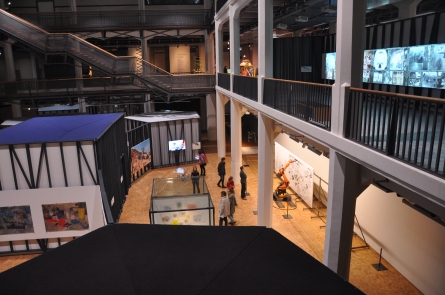Last weekend we went with a bus full of 42 VU students and staff and some guests to Karlsruhe, to visit the ZKM (Center for Art and Media). At the occasion of the 300 year anniversary of the famous ‘fan city’, the ZKM featured the so called ‘GLOBALE’ a set of exhibitions exploring what ZKM director Peter Weibel envisions as a ‘Renaissance 2.0’, a new step in the evolution of mankind driven by a renewed merging of arts and sciences.
With four (or six?) exhibitions on show at ZKM, and with such a big group, probably everbody chose their own highlights – let me just name some of mine (which, I have to admit, are rather on the arty side, while there were also more scientific and even rather ‘gimmicky’ exhibits):
In the ‘Infosphere’ exhibition, EMMA CHARLES’ video ‘FRAGMENTS ON MACHINES’, a tracking shot of Manhattan’s signature buildings reflected the strange ambivalence of the city’s 20th century architecture representing economic power, and the real economic infrastructure more and more moving into the partly subterranean landscape of server farms and control rooms. While this film can actually also be seen online, there where also impressive ‘analogue exhibits’ like the huge visualization of THE 8th SPHERE by BUREAU D’ÉTUDES or the TELE-PRESENT WATER by DAVID BOWEN, a beautiful kinetic sculpture visualizing a life transmission of data from a sea buoy in the pacific ocean. Other participants ‘exhibitionized’ their time-based works by staging them in installations: STÉPHANE DEGOUTIN & GWENOLA WAGON invited visitors into a tentlike structure to sit on tree trunks inbetween staples of books, to watch the video fragments of their ‘non-linear essay film’ ‘WORLD BRAIN’, a renewed vision on the ‘planetary network’ combining documentary material on information processing with, amongst others, the documentation of some contemporary forest survival experiment.
Also HITO STEYERL, in the ‘Global Control and Censorship’ exhibition, presented a spatial installation where visitors could actually put some of the strategies promoted in her video ‘HOW NOT TO BE SEEN, A FUCKING DIDACTIC MOV.FILE’ into practice. While other exhibits of this show were rather didactic in nature (such as the entrance requiring to or leave a DNA sample, or a fingerprint, or a data sample), it also included installations by ubermorgen.com and Julia Sher, wall drawings by Dan Perjovschi or the CCTV sculpture TURUL by ERIK MATRAI.
‘Exo-Evolution’ showcased numerous scientific and artistic works exploring the man-nature-technology triangle, proposing both existing and fictitious examples of a technology-enhanced ecosystem. While an example for the fictitous approach was PINAR YOLDAS’ ‘ECOSYSTEM OF EXCESS’ consisting of speculative organisms which can perceive, digest and clean plastic, ‘FOREST LAW’ a cooperation of German Artist URSULA BIEMAN with Ecuadorian architect PAOLO TAVARES dealt with the actual situation in the ecuadorian rain forest, albeit from an artistic perspective. Ecuador has been the first state to include the rights of nature into its constitution, and the project documents the fight of the indigenous people to claim these rights and protest against oil mining projects. Another highlight was CAMILLE HENROT’s LA GROSSE FATIGUE, an evolutionary history of the world staged by means of contemporary conceptualizations, image material and exhibits from the Smithsonian Institute in Washington DC, and online found footage – in which rightfully so had won the Silver Lion at the 2013 Venice Bienial.
And, as a big surprise, Ankie discovered that the Infosphere exhibition actually featured a work co-produced by VU scientists: the so called SYMBIOTIC MACHINE, which “harvests energy from photosynthetic organisms, applying this energy to movement to be able to collect photosynthetic organisms again” (a collaboration by artist IVAN HENRIQUES with VU physicists RAOUL FRESE & VINCENT FRIEBE). Apparently, it was shown in the Amstelpark Glazen Huis in the summer of 2014 and even won a Honorary Mention at Ars Electronica…
Last but not least, there was the ‘Global Games‘ exhibition which contrasted the legendary ZKM collection of early game consoles with more recent games addressing issues of globalizations, migration, and feminism, amongst others.
While I somewhat pity that in the end time was to short or the group to big to have more discussions about individual works, I very much enjoyed going back to some of the exhibits with smaller groups of people on Sunday. Others rather opted for a Renaissance (and Baroque) 1.0 Sunday, visiting the extraordinary collection of the Kunsthalle, Bruchsal palace and the city of Karlruhe itself.

Anyway, the size and mix of the group made it into a hilarious trip, including the joint dinner experience at the Badisch Brauhaus (and I swear I had no idea they had a slide to the bathrooms when I reserved the table), the chance to enter the Internet physically offered by our hostel, and a mysterious shell case the origin of which Ingrid and I are still researching. Its content however provides some hilarious comments on the trip, which prove that despite all exo-evolutionary theory, in the end it all comes back to embodied cognition. (KK)
“as I sat down, knees on the towel, in front of the toilet, on the tiled bathroom floor, hugging the pot, waiting for the next wave of sick to hit, I suddenly realized the connections between the Ecuadorian shaman in court and the utopian plastic processing organs.”



![IMG_20160131_162313[1] Bureau d'Études, The 8th Sphere](https://vuartandculture.files.wordpress.com/2016/02/img_20160131_1623131.jpg?w=446&resize=446%2C335&h=335#038;h=335)





![IMG_20160203_223413[1] IMG_20160203_223413[1]](https://vuartandculture.files.wordpress.com/2016/02/img_20160203_2234131.jpg?w=371&resize=371%2C278&h=278#038;h=278)
